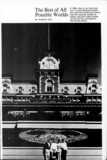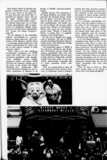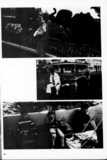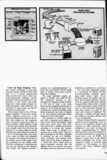



In 1984 that is, an hour from no – ll well-behaved citizens who meet their production norms, have the requisite number of babies, and don't make trouble, will be sent for a fortnight to Walt Disney World.
Walt Disney World is Paradise Regained or Grimsville, U.S.A., depending on your vision of the good life. It's neat and clean and really keen-a shrewdly-run pleasure dome with all the rough, raucous edges sanded away. It's a great big Florida orange -- but without much juice. It's an ocean of polite agreeableness, with an undercurrent of uptightness (Hippie types, keep out.) It's know-how apotheosized (see "Under the Magic Kingdom," page 39).
It's the epitome of the controlled, ordered environment-its creator's obsessive dream-come-true. (Isn't animation-Walt Disney's original thing -a technique which enables you to do without unpredictable live actors and be in total control yourself of what goes into a film?)
There doth it lie-this enormous incorporated community of 27,000 acres-this Ultra New Town of no permanent population-only straight- arrow highways, tamed foliage, pumped-in lakes, and swank hotels that line the roadway, leading you to the heart of the matte – he Magic Kingdom!--the carbon-copy East Coast Disneyland designed to give as much reassurance as pleasure to its throngs of Middle American-minded visitors.
[…]
Under the Magic Kingdom. Pollution control technology is the most amazing wonder at Disney World. But most of it is buried underground where tourists never see it. Three currently-being-tested pollution control techniques that have potential for application in New Towns and other large-scale urban design projects include pneumatic trash collection, the recycling of waste water and the reclamation of waste heat.
After raising much of the 100-acre Magic Kingdom 12 feet above grade, Disney engineers carved out a network of underground corridors (above, left) that connect to the kingdom's major structures. From the ceiling of these corridors, called utilidors, hangs a 24-inch pipe system that pneumatically propels trash from all over the property to a central collection point. Beneath the trash collection system lie a set of 18-inch pipes that carry waste water-most of which will ultimately be recycled. And along the bottom of the utilidor run yet other pipes carrying reclaimed hot and chilled water. Electrical wiring and a ventilation system are also housed in the utilidors. And finally, the utilidors provide a roadway for electrically-powered vehicles that haul Disney World's small army of workers from point to point within the kingdom.
[…]